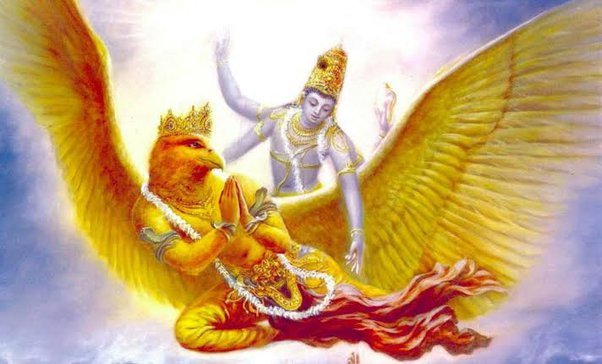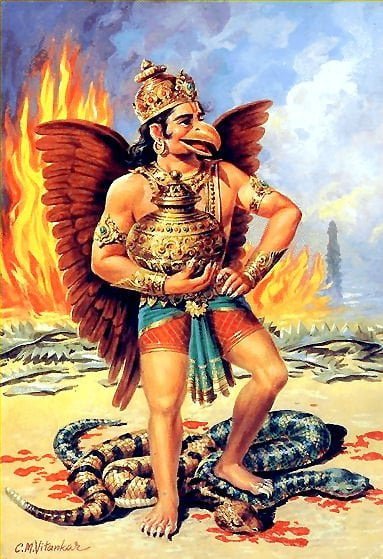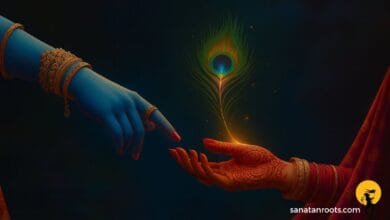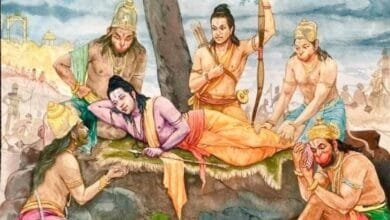What Was Lord Vishnu’s Vahana? | Meaning and Symbolism of Garuda – The Divine Vehicle of Vishnu

In Hinduism, every deity is associated with a vahana — a divine vehicle that not only serves as their means of transport but also symbolizes their energy, virtues, and cosmic purpose. Among them, Lord Vishnu, the Preserver of the Universe in the Holy Trinity (Trimurti), is depicted riding his magnificent vahana — Garuda, the mighty eagle-like divine being.
But who exactly is Garuda, and what is the deeper meaning behind this celestial bond between Vishnu and his vahana? Let’s explore the mythology, symbolism, and spiritual significance of Garuda — the eternal companion of Lord Vishnu.
Who Is Garuda – The Divine Eagle
Lord Vishnu’s Vahana Garuda is one of the most powerful and revered figures in Hindu mythology. Described as a giant bird with a golden body, a white face, red wings, and a sharp beak, Garuda symbolizes strength, courage, and speed.
According to the Puranas, Garuda is the son of Sage Kashyapa and Vinata, making him the half-brother of Aruna, the charioteer of the Sun God, Surya.
In Sanskrit, the name Garuda means “the devourer” — one who swallows evil, ignorance, and darkness. His very presence is said to repel negativity and destroy harmful influences, especially snakes, who are his eternal enemies.
The Mythological Story of Garuda and Lord Vishnu
The bond between Lord Vishnu and Garuda is deeply spiritual and rooted in devotion.
According to legend, Vinata (Lord Vishnu’s Vahana Garuda’s mother) was enslaved by her co-wife Kadru because of a deceitful bet. To free his mother, Garuda sought the nectar of immortality (amrita) from the gods, as demanded by the serpents (Kadru’s sons).
After an intense and courageous battle against the gods guarding the nectar, Garuda succeeded in bringing it but refused to consume it himself — a symbol of selflessness and purity.
Pleased by his devotion, Lord Vishnu blessed Garuda with immortality and made him his vahana (vehicle) and flag emblem (Garuda-dhwaja). From that moment on, Garuda became the eternal companion of Vishnu, always seen carrying him across the heavens.
Symbolism Behind Garuda as Vishnu’s Vehicle
Garuda is not merely a mythological bird — he is a profound symbol of spiritual liberation and divine service. Each aspect of his being carries deep meaning:
- Wings of Speed: Representing time and mobility, Garuda’s wings remind us that divine will transcends space and speed.
- Eagle Eyes: Symbolize sharp perception and wisdom — the ability to distinguish truth from illusion.
- Snake Enemy: His enmity with snakes symbolizes victory of truth over deceit and knowledge over ignorance.
- Vehicle of Vishnu: As Vishnu’s vahana, Garuda signifies the power of devotion (bhakti) that carries divine preservation through the universe.
Just as Vishnu sustains life, Garuda symbolizes the spirit that lifts humanity toward divine consciousness.
Representation of Garuda in Hindu Iconography
In temples and sculptures, Garuda is often shown as a half-man, half-eagle figure with folded hands, kneeling in devotion before Lord Vishnu.
In South Indian temples, Garuda is sometimes placed facing the sanctum, eternally watching over Vishnu.
Many devotees also worship Garuda Dandakam or chant Garuda Gayatri Mantra to seek protection from negative energies and serpent afflictions (sarpa dosha).
Garuda is also revered in Buddhism and Jainism, as well as in Southeast Asian cultures such as Indonesia, Thailand, and Nepal, where he symbolizes royal power and divine protection. In fact, Garuda is the national emblem of Indonesia, representing strength and freedom.
Lessons and Spiritual Meaning of Vishnu’s Vahana
The relationship between Vishnu and Garuda teaches several timeless lessons:
- Devotion and Service: Garuda’s devotion to Vishnu shows how true service is born from love, not obligation.
- Courage and Righteousness: He reminds us to stand fearlessly for truth, even against the gods if needed.
- Detachment and Discipline: Despite his might, Garuda remains humble — a lesson in using power for good.
- Freedom from Ignorance: Garuda’s flight represents liberation (moksha) — the soul rising above worldly bondage toward divine light.
In this way, Garuda serves not only as a divine vehicle but also as a metaphor for the human spirit striving toward enlightenment under Vishnu’s guidance.
Conclusion: The Eternal Bond Between Vishnu and Garuda
The story of Lord Vishnu and Garuda is a timeless reminder that devotion, courage, and selfless service can elevate the soul closer to divinity.
Garuda’s loyalty and strength complement Vishnu’s compassion and wisdom — together symbolizing the perfect harmony between power and preservation.
Even today, devotees chant “Om Garudaya Namah” to seek protection, wisdom, and freedom from fear.
Every time we see Vishnu riding Garuda across the skies of mythology, it inspires us to soar beyond limitations and embrace divine truth.
✨ Quick Facts About Lord Vishnu’s Vahana – Garuda
- Vahana Name: Garuda
- Form: Eagle-like divine being
- Parents: Sage Kashyapa and Vinata
- Symbolism: Speed, wisdom, protection, and devotion
- Enemy: Serpents (Nagas)
- Representation: Seen carrying Lord Vishnu in temple idols and images
- Mantra: Om Garudaya Namah

Discover more from Sanatan Roots
Subscribe to get the latest posts sent to your email.


